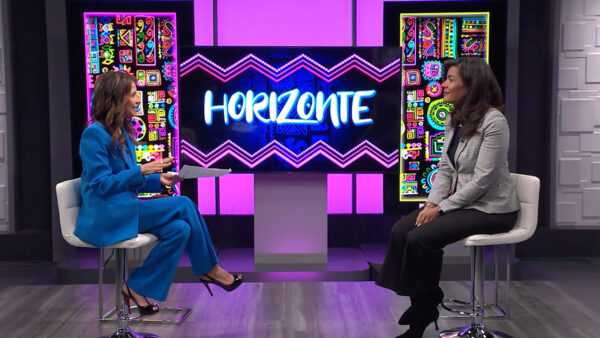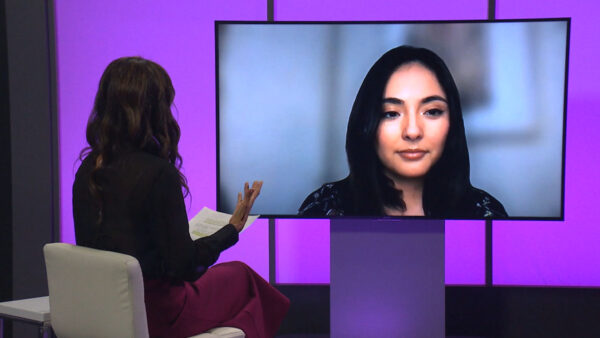“Friends of Mexican Art celebrate 50 Years of Collecting and Giving” highlights more than 60 works of art on display at Phoenix Sky Harbor Airport Terminal 4. The exhibition is a collaborative effort between the Phoenix Airport Museum and The Friends of Mexican Art (FOMA), a local nonprofit that focuses on collecting pieces by Mexican artists. Phoenix Airport Museum curator Lennée Eller and FOMA member Teresa FitzRandolph talk about the exhibition.
José Cárdenas: The next time you're at terminal four at Phoenix Sky Harbor airport you may notice a unique display of Mexican art. Friends of Mexican art celebrate 50 years of collecting and giving is a collaborative exhibition between the Phoenix airport museum and the friends of Mexican art known as FOMA, a local nonprofit organization comprised of people who collect, donate, and promote art by Mexican artists. Here with me tonight is Lennée Eller and Teresa FitzRandolph. Let's start with one of the cases that we have. As I understand there are two cases and a gallery for people to see. We have some pictures to put up on the screen now. This is one of the cases people can go and see. I want to talk about that big piece in the middle, which is also on the brochures. Tell us about that.
Lennée Eller: That wonderful piece is from -- a special town, and there's a very special artist, this is the artist who made this piece, Delfino Sanchez.
José Cárdenas: This is ceramic?
Lennée Eller: It's all ceramic. He's the one that invented this style. Now has made a name -- pottery is now that's what people go to buy there. He's the one who originally made this ceramics there in the area and developed that style. It became very popular with American collectors. So they would travel to very remote region and buy this ceramic. You know him well.
José Cárdenas: We have two cases of folk art there. We have some pictures of the other case. This is the other one, one side of it, and then we have a picture of the other side, a particular piece we want to talk about right in the middle. That's the tree of life.
Lennée Eller: Yes, it is. These two cases are real special. The first case --
José Cárdenas: We have a closeup of that particular piece. There it is.
Lennée Eller: It is FOMA. The FOMA is a private collection. This group of work is from the Heard Museum. For the ma members purchased this collection for the actual Heard Museum in 1979. The idea was to have as much ceramic from all different states and regions of Mexico, so they have this wonderful collection of over 400 pieces of art in this collection. We only had a small sampling of it but this piece is the tree of like, known for the tree of life. Over the years it's developed more and more. There are so many families that specialize in that region in particular. That particular piece is --
José Cárdenas: It's gorgeous.
Lennée Eller: It's wonderful piece.
José Cárdenas: Teresa, you're a long time member of FOMA.
Teresa FitzRandolph: Yes.
José Cárdenas: Tell us about the organization and then we'll talk about how it came to be these pieces were donated for exhibition purposes.
Teresa FitzRandolph: Sure. It was started by Sol Levy. She was the first president in 1963. They got together with 30 people and they put up a show with about 40 paintings. It was such a success that 30 people got together and organized themselves as friends of Mexican art.
José Cárdenas: Ever since they have been doing things to buy pieces for the Phoenix art museum and we just heard --
Teresa FitzRandolph: Their aim is really to learn more about the Mexican culture, to bring it to the states, to promote understanding and knowledge about the culture of Mexico and they do that through exhibits, through acquisitions for not only the Phoenix museum, the Heard Museum and the ASU art museum.
José Cárdenas: As we discussed you are from Mexico yourself.
Teresa FitzRandolph: Sure.
José Cárdenas: I can understand your passion for Mexican art, but what motivates people born and raised in the United States? Why this passion for Mexican art?
Teresa FitzRandolph: They get to understand more their neighbor to the south. It brings more understanding of the culture of our neighbors. It brings more friendship. It brings more friendship and trade between Arizona and the country of Mexico.
José Cárdenas: So there's a very valuable social, interrelationship?
Teresa FitzRandolph: Not only social but also very beneficial because we learn about who our neighbors are. Our neighbors come to us for entertainment, shopping, trade. In fact another person who was very involved in the forming of FOMA was Dr. Francisco from the American institute for foreign trade.
José Cárdenas: So it has many, many ways in which it touches the people in the valley. I want to talk about some of the specific things that the organization does, but going back to the art, Lennée, there's a gallery at the airport.
Lennée Eller: Yes.
José Cárdenas: We have some fine art in there. We have artists such as --
Lennée Eller: The gallery is in terminal 4. Make sure everybody finds it. Terminal 4, level 3. This gallery is a real key pin for a lot of people when they visit the airport. They see really wonderful things. In this particular exhibition the three major artists --
José Cárdenas: They called them the big three.
Lennée Eller: As well as Diego Rivera. We don't have Diego Rivera, but we have the other two showing in the exhibition. The second one is the three generations, an American also known as La Familia.
José Cárdenas: And this is the Orozco.
Lennée Eller: This exhibit shows the diversity and the strength of work from the historical perspective as well as contemporary.
José Cárdenas: When you talk about diversity you really mean diversity. This next piece, Luis Cuerva, he was a contemporary of the big three, but he was a rebel.
Lennée Eller: Very much so. He was called the bad boy of the Mexican artists. He just wanted to rebel against what he called the propaganda machine of the muralists. This is a portrait of a very famous art critic and lawyer and writer of that region, so he would do more -- he just caused a lot of trouble whenever possible, so he set the standards for rebelling against traditional muralist movement.
José Cárdenas: We have some other pieces, artists who, one of whom at least is no longer alive, but not really contemporaries of the big three but in between. Many people may recognize this.
Lennée Eller: What's interesting, they think it is tame. Oh, it's just a beautiful picture of a beautiful woman because he did a lot of contemporary women. What's important to know, these are the women from Oaxaca, known to be very good business women, very strong in spirit and opinion. So, he loved those women and he painted them and drew them and made sculptures of them all the time.
José Cárdenas: I think a lot of Arizonans would look at that and think of R.C. Gorman. R.C. Gorman studied with him.
Lennée Eller: R.C. Gorman copied him.
José Cárdenas: Both. Both. We have an artist of about the same era.
Lennée Eller: Pedro Frederberg --
José Cárdenas: A good Mexican name.
Lennée Eller: Yes. He also wanted to be one of those -- sort of an avant-garde artist. He's well known for the chair hand. It's a chair that you sit in that's a hand. He was more of a graphic artist as well. So you can see that in his work.
José Cárdenas: Then we have what you might call the more contemporary artists represented. We have several pictures here.
Lennée Eller: They are , 39, 40 years old. This one is Fernando -- sorry. ANDRIOSSI. He's more of a magic realism artist. He comes from that genre. He's doing work that's more personal and more contemporary.
José Cárdenas: The next one is kind of a throw-back to the political art around the time of the Mexican revolution, but it's a contemporary artist.
Lennée Eller: Very contemporary subject matter. This is Rodriguez. The subjects are all subject matters of today. He's also published several books of his own child, telling stories as well. So it's of that old type of tradition of the wood cuts the printers of the time, but in a very contemporary way.
José Cárdenas: There are some magnificent pieces that friends of Mexican art have acquired, donated or lent for exhibition. Tell us more about the organization. How does it rate? -- operate? How does it raise funds?
Teresa FitzRandolph: Yes. One of the aims was to donate sufficient works of art of great quality to the Phoenix art museums to establish the first gallery of Mexican art in this side of the Mississippi. They accomplish that very well. They do that by fund-raisings of the Mexican Mercado in the Hacienda tour done every year. In addition to that, every month they have lectures or seminars or visits by experts, Mexican art.
José Cárdenas: We put the website on the screen a moment ago. I assume people can go and get more information about the organization.
Teresa FitzRandolph: I encourage everyone to look us up. Contact us. Please attend some of our programs. They are very interesting, very well researched and they have very good quality of art for us to see or to donate or culture programs for us to learn.
José Cárdenas: It's a great organization. We only have about a minute left. Tell us about the airport exhibitions and how long is this particular exhibition going to be up.
Lennée Eller: This one would be up -- the gallery will be up edge February 23, and the caseless be up until March 16. It's a great time to come to the airport a little early, check out the culture when you're there. You can get more information on our website at skyharbor.com.
José Cárdenas: People can enjoy this magnificent art. Thank you so much for joining us on Horizonte. This is a real treat.
Lennée Eller:Curator, Phoenix Airport Museum; Teresa FitzRandolph:FOMA member;























